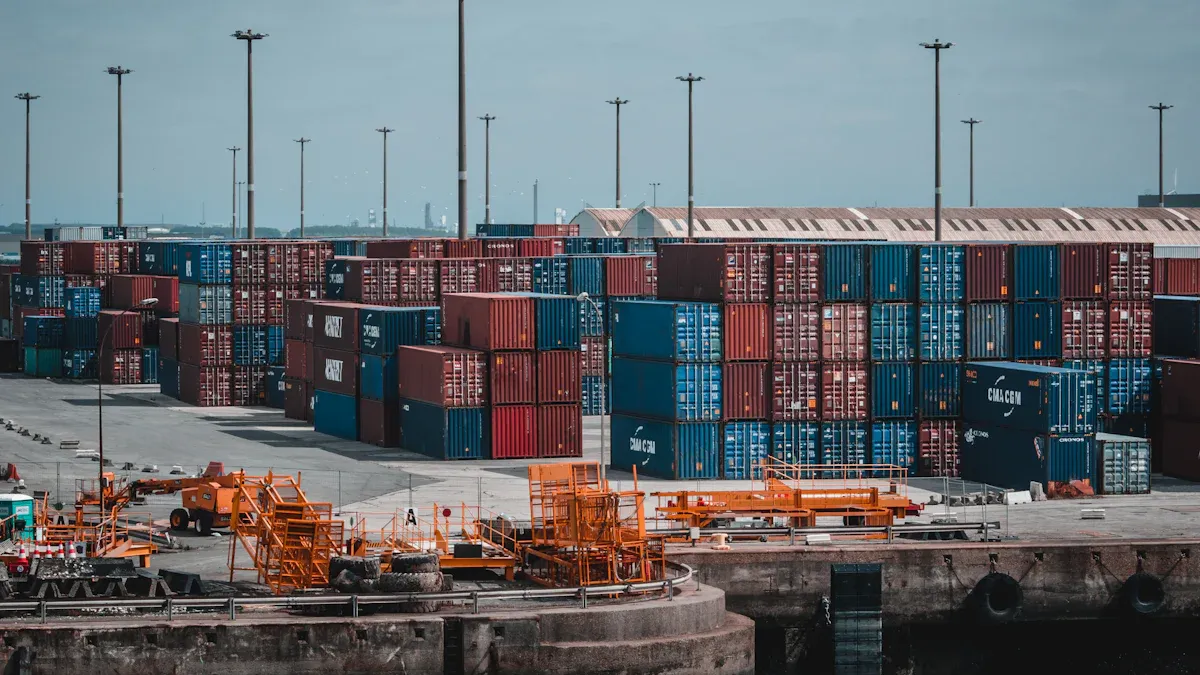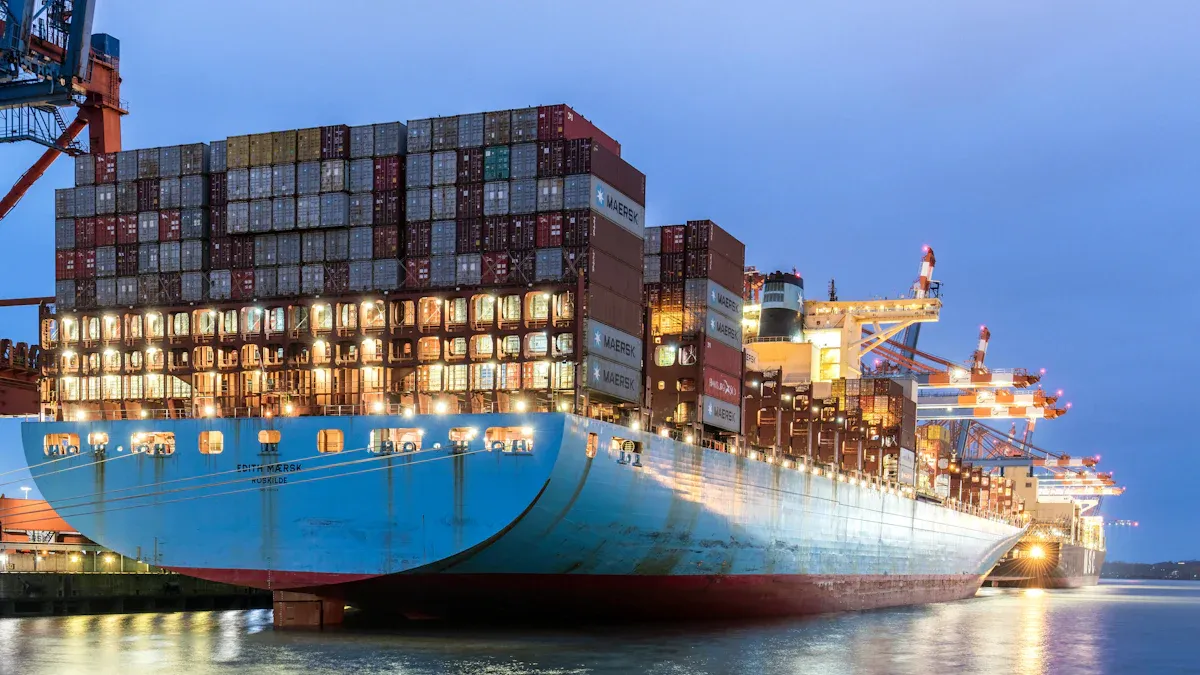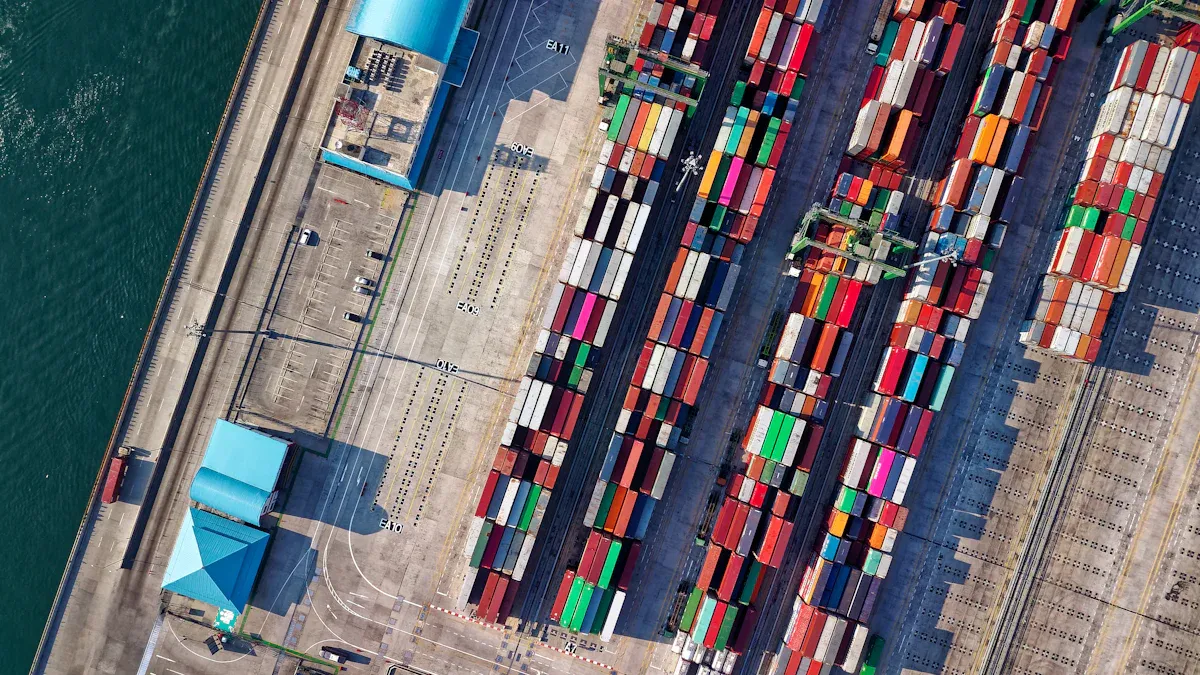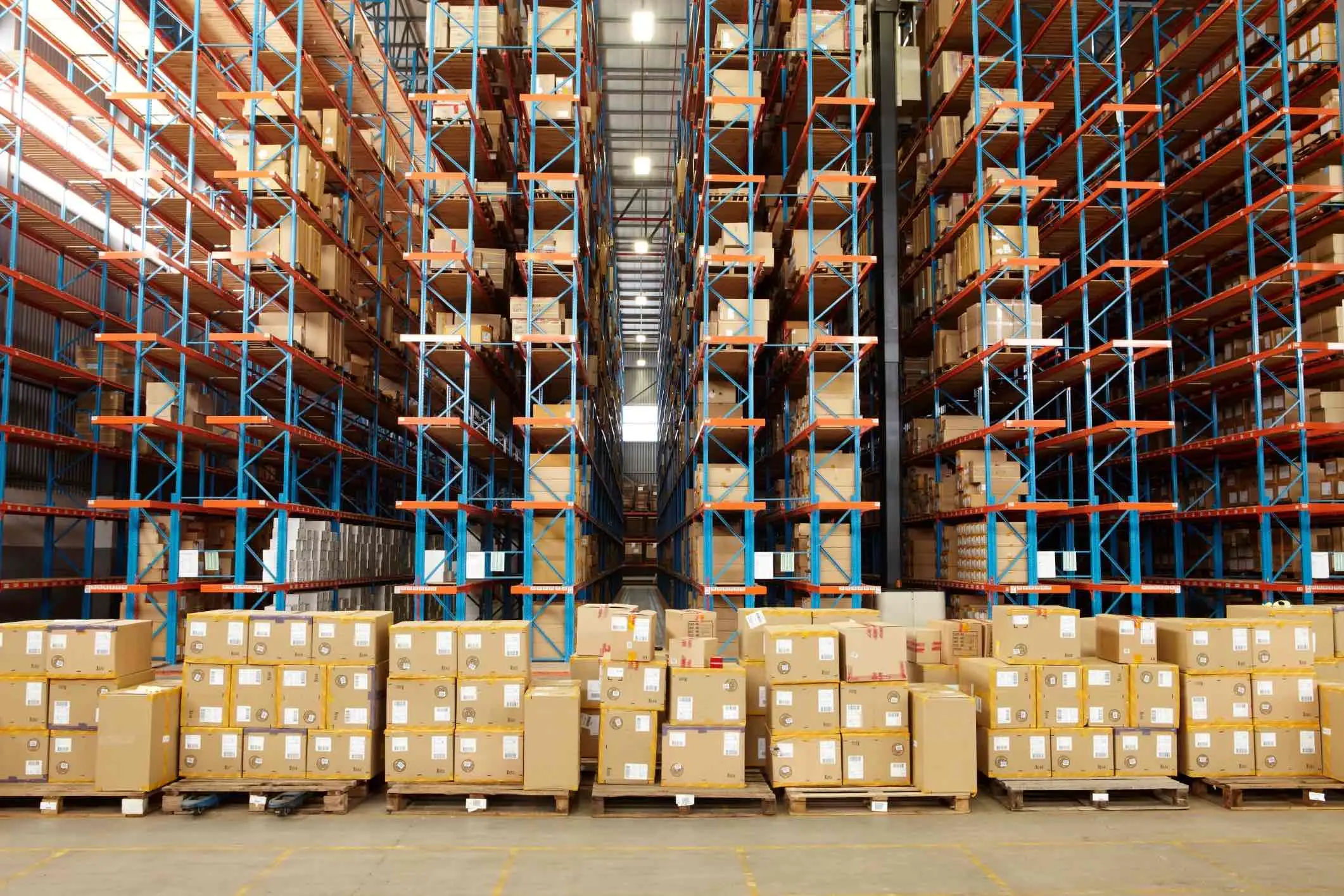The Biggest Obstacles in Global Logistics Transportation and How to Address Them

Global logistics faces immense challenges that disrupt supply chains and economic stability, particularly in the realm of overseas logistics transportation. For instance, the transportation and logistics sector supports $89 billion in global trade, yet 77% of companies report supply chain insurance gaps. Meanwhile, logistics costs in India reach 14–18% of GDP, underscoring disparities in shipping efficiency across regions.
Key Takeaways
Spending money on better roads and ports is important. It helps goods move faster and grows the economy.
Use JUSDA's JusLink tool to track shipments live. This tool shows where items are and stops late deliveries.
Use machines and teach workers new skills to fix worker shortages. Train staff to use new tools and make shipping better.
Infrastructure Challenges in Overseas Logistics Transportation

Inadequate Transportation Networks and Port Congestion
Inadequate transportation networks and port congestion represent some of the most common challenges in overseas logistics transportation. Ports often struggle to handle the growing volume of global trade due to outdated infrastructure and insufficient investment. For example:
Research shows that the quality of port infrastructure directly impacts logistics performance and economic growth, especially in developing countries.
In East Africa, poor logistics infrastructure, including inadequate customs facilities, has been linked to low export competitiveness.
Port congestion occurs when the number of ships waiting exceeds a port's capacity to process them efficiently. This issue arises from demand surges, labor shortages, extreme weather, and equipment limitations. The consequences include delayed inventory, missed sales opportunities, and increased shipping costs. Geopolitical tensions and environmental regulations further complicate the situation, forcing shipping companies to reroute vessels and increasing congestion at alternative ports.
Inadequate transportation networks exacerbate these problems by limiting the efficient movement of goods. Without proper road, rail, or air connections, cargo handling slows down, leading to unforeseen delays at ports. Labor shortages and outdated facilities compound these issues, making it difficult for ports to manage increased shipment volumes.
The Role of JUSDA's Global Warehousing Solutions
JUSDA's global warehousing solutions play a pivotal role in addressing infrastructure challenges in overseas logistics transportation. With over 2.5 million square meters of warehouse space across multiple regions, JUSDA provides a robust network to support efficient cargo movement. These facilities include advanced features like real-time inventory tracking through JusLink and eVMI systems, ensuring transparency and control for businesses.
For instance, JUSDA's warehouses in Vietnam offer clean room facilities and value-added services such as picking, packing, and labeling. These capabilities help streamline logistics operations, reducing delays caused by inadequate infrastructure. By strategically locating warehouses near major ports and transportation hubs, JUSDA minimizes the impact of port congestion and ensures timely delivery of goods.
Additionally, JUSDA's collaboration with customs authorities simplifies the clearance process, further mitigating delays. This comprehensive approach enhances supply chain efficiency, making JUSDA a trusted partner for businesses navigating the complexities of global logistics.
Solutions: Investing in Infrastructure and Alternative Routes
Investing in infrastructure is essential for overcoming major challenges in transportation logistics. Improved port facilities, modernized equipment, and expanded transportation networks can significantly enhance efficiency. Studies highlight that infrastructure investments not only boost logistics performance but also drive economic growth by lowering trade costs and increasing export competitiveness.
Alternative routes offer another effective solution. When geopolitical tensions or environmental regulations disrupt traditional shipping lanes, rerouting vessels to less congested ports can prevent delays. For example:
Infrastructure investments provide long-term returns, including inflation hedging and portfolio diversification.
They also offer downside protection and yield benefits, making them a valuable asset for businesses.
Governments and private sectors must collaborate to fund these projects. By prioritizing infrastructure development and exploring alternative routes, you can mitigate the risks associated with inadequate transportation networks and port congestion. This proactive approach ensures smoother operations in overseas logistics transportation, ultimately benefiting global trade.
Delivery Delays in International Transportation

Delivery delays remain one of the most common challenges in international transportation. These delays disrupt supply chains, increase costs, and reduce customer satisfaction. Understanding the causes and implementing effective solutions can help you mitigate these issues and maintain smooth operations.
Causes: Weather, Geopolitical Tensions, and Customs Delays
Several factors contribute to delays in international freight shipping. Weather disruptions, such as hurricanes or snowstorms, can halt operations at ports and airports. Geopolitical tensions, including trade disputes or regional conflicts, often lead to rerouted shipments and longer transit times. Unexpected customs regulations also play a significant role. For instance, changes in import/export policies or stricter inspections can slow down the clearance process, leaving goods stranded at borders.
Driver shortage further exacerbates these issues. A lack of skilled drivers delays the movement of goods from ports to warehouses or final destinations. This shortage creates bottlenecks in the supply chain, especially during peak seasons when demand surges. Addressing these causes requires a proactive approach to minimize disruptions in international logistics.
Leveraging JUSDA's JusLink for Real-Time Tracking
JUSDA's JusLink platform offers a powerful solution to combat delivery delays in international transportation. This advanced technology enhances real-time tracking, giving you complete visibility and control over your shipments. With JusLink, you can monitor the movement of goods across the supply chain, identify potential risks, and resolve issues proactively.
For example, JusLink facilitates dynamic inventory management, ensuring that you can adjust stock levels based on real-time data. It also supports risk management by providing end-to-end visibility, allowing you to anticipate and address disruptions before they escalate. By leveraging JusLink, you can improve operational efficiency and ensure timely deliveries, even in the face of major challenges.
Solutions: Contingency Planning and Predictive Analytics
To address delivery delays effectively, you need robust contingency planning and predictive analytics. Contingency planning involves preparing alternative strategies to handle disruptions. For instance, you can identify backup routes or carriers to ensure uninterrupted international freight shipping. Predictive analytics takes this a step further by using data to forecast potential risks and develop proactive solutions.
Predictive freight analytics can identify risks like weather disruptions, geopolitical conflicts, and port congestion. These insights allow you to prepare effective contingency plans. Additionally, advanced methods such as Sentiment Analysis, Scenario Analysis, and Monte Carlo Simulation help forecast disruptions like natural disasters or supplier delays. Implementing these tools can reduce supply chain vulnerabilities by up to 40%, ensuring smoother operations.
By combining JusLink's real-time tracking capabilities with predictive analytics, you can create a resilient supply chain. This approach not only minimizes delays but also enhances your ability to adapt to the complexities of global logistics.
Workforce Shortages in Global Logistics
Driver and Skilled Labor Shortages
Workforce shortages remain one of the major challenges in global logistics, particularly in finding qualified drivers and skilled labor. The logistics industry faces a growing gap between demand and supply for workers, which disrupts supply chains and reduces efficiency. For example, the International Labour Organization (ILO) reports that the global labor force participation rate has dropped to 58.4%, its lowest in over a decade. In North America, 73% of logistics companies struggle to find qualified workers, according to the Council of Supply Chain Management Professionals (CSCMP).
Driver shortages further complicate the situation. Detention rates at stops, especially for refrigerated drivers, reach as high as 56.2%, leading to significant productivity losses. In 2023 alone, for-hire drivers lost 135 million hours to detention, resulting in $3.6 billion in direct financial losses and $11.5 billion in productivity losses. These statistics highlight the urgent need for solutions to address workforce shortages in logistics.
Automation and Training Programs as Solutions
Automation and training programs offer effective solutions to workforce shortages. Companies like DHL and Amazon have successfully implemented robotics and automation to enhance efficiency. DHL deployed Locus Robotics AMRs (Autonomous Mobile Robots) to address a 15% staffing shortfall during peak seasons, achieving a 200% increase in throughput and a 25% reduction in temporary labor. Similarly, Amazon expanded its robotics fleet to 200,000 units, reducing fulfillment costs by 15%.
Training programs complement automation by equipping workers with the skills needed to operate advanced technologies. For instance, DHL introduced pilot programs to train employees alongside automation deployment. These initiatives ensure a smooth transition for workers while maintaining operational efficiency. By combining automation with workforce training, you can address labor shortages and improve logistics performance.
JUSDA's Role in Workforce Optimization
JUSDA plays a pivotal role in optimizing the workforce within global logistics. Through its JusLink platform, JUSDA enhances operational efficiency by integrating real-time tracking and dynamic inventory management. This reduces the reliance on manual labor and streamlines logistics operations. Additionally, JUSDA invests in workforce development by offering training programs tailored to industry-specific needs. These programs empower workers to adapt to technological advancements, ensuring a skilled and capable workforce.
By leveraging automation and training, JUSDA helps businesses overcome common challenges in workforce shortages. Its innovative solutions not only address immediate labor gaps but also prepare your logistics operations for future demands.
Compliance Complexities in Global Logistics
Navigating International Trade Regulations
Navigating international trade can be daunting due to the complexity of regulations. Misclassification of goods often causes delays at borders, while stricter environmental laws demand sustainable practices like reducing carbon emissions. Safety standards protect workers but require careful adherence to avoid penalties. Data protection laws, such as GDPR, add another layer of complexity when handling customer information. Transportation regulations vary across regions, impacting how goods move globally. These challenges increase costs and slow down operations, making compliance a critical focus for businesses engaged in global trade.
JUSDA's Expertise in Customs Coordination
JUSDA simplifies customs coordination by leveraging its extensive experience and advanced tools. With a presence in over 155 service points worldwide, JUSDA ensures smooth navigation through international paperwork and requirements. Its JusLink platform provides real-time visibility into customs processes, reducing delays and improving compliance rates. By collaborating with customs authorities, JUSDA helps you overcome the challenges posed by changing international regulations. This expertise ensures that your shipments move efficiently, minimizing costs and avoiding unnecessary disruptions.
Solutions: Digital Tools and Expert Partnerships
Digital tools and expert partnerships offer effective solutions for managing compliance complexities. Real-time performance metrics help you identify gaps and mobilize teams to address them. For example, JusLink enables you to track compliance rates and improve processes dynamically. Partnering with providers who meet rigorous standards ensures brand alignment and adherence to regulations. Educating internal teams and affiliates on compliance processes further strengthens your operations.
Metric Type | Description |
|---|---|
Holistic Solutions | Measure, manage, and improve performance for effective compliance solutions. |
Brand Adherence | Ensures consistency in brand messaging and compliance across multiple partners. |
Compliance Metrics | Evaluates compliance rates and identifies areas for improvement in digital marketing initiatives. |
By combining digital tools with expert partnerships, you can reduce costs, enhance compliance, and adapt to the demands of global logistics.
Technology Barriers in Global Logistics
Lack of Integration Across Supply Chain Systems
Technology integration challenges often hinder the efficiency of freight logistics. High implementation costs, cybersecurity risks, and the need for new skill sets complicate the adoption of advanced systems. Collaboration among supply chain partners adds another layer of complexity, as activities require seamless coordination across multiple platforms.
Integration Type | Impact on Supply Chain Performance |
|---|---|
Internal Integration | Enhances operational efficiency and financial performance. |
Supplier Integration | Improves collaboration and reduces delays in freight logistics. |
Customer Integration | Boosts customer satisfaction and streamlines logistics management processes. |
Without proper integration, freight logistics systems fail to deliver optimal results. This lack of connectivity limits operational efficiency and financial gains, making it harder for you to compete in the global logistics landscape.
Enhancing Visibility with JUSDA's JusLink Platform
JUSDA's JusLink platform addresses these challenges by providing real-time visibility across supply chains. With JusLink, you gain access to dynamic inventory management and accurate tracking, which significantly improve freight logistics operations. For example:
Accuracy increases by 78%, ensuring better decision-making.
Inventory turnover improves, reducing storage costs and enhancing logistics management.
JusLink empowers you to monitor freight movements, anticipate disruptions, and optimize supply chain processes. By leveraging this platform, you can overcome technology barriers and achieve seamless freight logistics operations.
Solutions: Advanced Technologies and Cybersecurity Measures
Advanced technologies and robust cybersecurity measures are essential for overcoming technological barriers in logistics management. Cutting-edge surveillance systems, IoT-enabled cargo tracking, and biometric access control enhance security and operational efficiency. Blockchain technology ensures tamper-proof records, while predictive analytics identifies potential risks before they escalate.
The logistics sector faces increasing cyber threats due to its reliance on digital technologies. In 2023, the shipping industry experienced 64 cyberattacks, highlighting the need for advanced solutions. By adopting AI and IoT, you can strengthen cybersecurity measures and protect your freight logistics systems from breaches. These technologies not only safeguard operations but also prepare you for the future, where 45% of supply chains are expected to operate autonomously by 2035.

JUSDA Solutions
To provide you with professional solutions and quotations.
Global logistics faces significant challenges, but solutions exist to overcome them. Investing in infrastructure enhances economic growth and logistics capabilities, as shown in emerging markets. Embracing technology improves productivity and market access. Workforce development boosts efficiency in shipping products and goods. Collaboration with experts and tools like JusLink ensures resilience in fluctuating shipping costs and freight costs.
Key Area | Findings |
|---|---|
Infrastructure | Drives economic growth in emerging markets. |
Digital Connectivity | Improves productivity and accessibility. |
Workforce Management | Enhances logistics efficiency. |
By addressing these areas, you can navigate complexities in global logistics and ensure smoother operations for air freight and other shipping needs.
See Also
Unveiling the Top Global Logistics Firms You Need to Know
Addressing Global Supply Chain Growth Issues Effectively
Navigating Future Logistics Through Innovative Digital Solutions
Understanding Current Trends in Logistics Risk Management
Exploring Innovative Logistics Technologies Shaping Tomorrow's Industry
